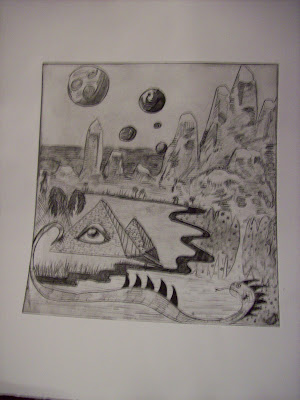
Hello and thanks for reading another entry!
Today I am going to talk about my latest project. It is a photopolymer etching. I can hear you say "Gee Mike, what is a photopolymer etching?" and I will try to explain in the best of layman's terms. Here we go!

Let's look for a moment at the word "photopolymer." We can see the first part,'photo'would most likely mean 'light' and 'polymer' would most likely refer to some kind of plastic. In this instance, photopolymer is a light sensitive plastic that is exposed to light to entrench the plate with your artwork, much in the way photographs and film "burn" images into light sensitive films. If you've read previous blogs, etching is a form of itaglio printing, which means the entrenched areas of the plate hold the ink and form the gestures of your composition.
Before you worry about the plate, however, you must first make a composition on frosted mylar with permanent medium that will be the image "burned" into the plate. The permanent medium can be wet or dry, opaque or transparent, but just so long as it is permanent.
From a technical standpoint, this is my third photo polymer etching and this one was made with different media than my first two. But, in this instance we are looking at an image created with a black Stibilo Aquarelle (watercolor) pencil. This was my first time using this approach in photopolymer, like I said, but also my first time using the Stibilo. It was much like working with an inkwash medium but with the ability to employ the semi-soft lines of a pencil. In my last two works in this media I used DecoColor paintmarkers for the most part but follow back into the plate with India Ink ink washes to add areas of gradation to the composition. The interesting thing about Stibilo in creating a compsition on mylar is that it cuts out the middle man of the ink bottle for the washy effects one can come to appreciate in the process of photopolymer etching! It is definitely a good idea to consider transparent washes because they add interesting charm to your plate.
Phew! I feel very detailed and longwinded when doing some of this explaining but I am trying to break it down as simply as I can.
Let's talk about the image:
Sometimes, much like in the way a song can stick in one's head, if I learn a new vocabulary word it just reprises in my mind over the course of days. Recently I learned the word "Bituminous" which refers to tar or petroleum in the earth. Somehow the word captivated me and I found myself thinking about elemental forces of earth and water, but more so, solid and liquid. I am truly fascinated by the concept of earth acting as a container for water. I also thought of a pre-historic aspect of tar and shale where fossils and bituminous matter take place.
On the image you can hopefully see some areas where there is wet brush among other various techniques achieved with the wet and dry capabilities of the stibilo pencil.
Thanks for reading!
No comments:
Post a Comment